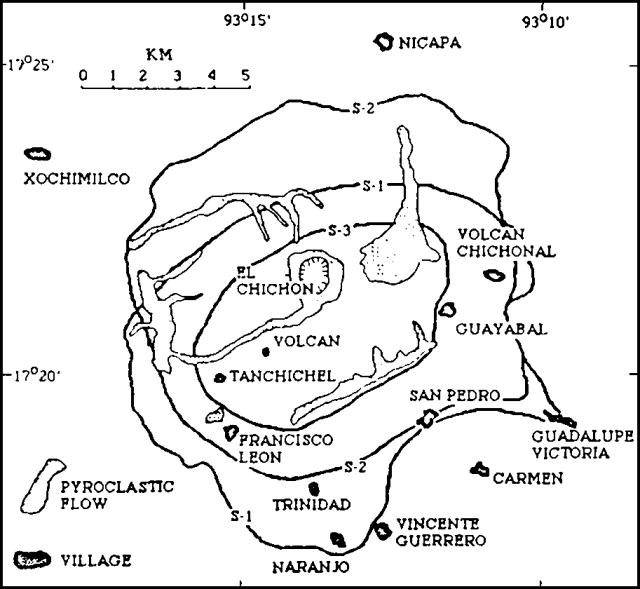Report on El Chichon (Mexico) — June 1982
Scientific Event Alert Network Bulletin, vol. 7, no. 6 (June 1982)
Managing Editor: Lindsay McClelland.
El Chichon (Mexico) No new explosions; dense stratospheric cloud over N hemisphere
Please cite this report as:
Global Volcanism Program, 1982. Report on El Chichon (Mexico) (McClelland, L., ed.). Scientific Event Alert Network Bulletin, 7:6. Smithsonian Institution. https://doi.org/10.5479/si.GVP.SEAN198206-341120
El Chichon
Mexico
17.3602°N, 93.2297°W; summit elev. 1150 m
All times are local (unless otherwise noted)
No large explosions have occurred at El Chichón since 4 April and weak ash emission was last observed 11 May. Minor microseismic activity was continuing in early July. The large stratospheric cloud ejected by the 4 April explosion remained dense over lower northern latitudes, but lidar measurements indicated that gradual northward dispersal was continuing.
Pyroclastic flows and casualties. Major erosion of pyroclastic flow deposits around El Chichón (figure 3) has taken place since the eruption. Some small accumulations of water remain associated with these deposits, but there have been no recent observations of large lakes such as the one that produced a fatal flood 26 May. The largest eruption killed many people in and near the village of Francisco León (~ 5 km SW of the summit), but initial reports that all of its residents died were incorrect, according to an American missionary who had lived in the village for many years. Many villagers who had fled the heavy tephra falls from the initial explosions 28-29 March, however, returned a few days later. About 140 residents of the village itself and a similar number from the countryside nearby were killed by the pyroclastic flow that destroyed the village 4 April (SEAN 07:05).
Stratospheric cloud. A late April-early May NASA flight collected stratospheric material at altitudes above 18 km over the western U.S. (including Alaska). The flight crew reported unambiguous evidence of the cloud as far N as the US-Canada border and estimated that it reached more than 21 km altitude. A preliminary examination of the material collected showed that it was a well-sorted assemblage of 5-10 µm plagioclase crystals and silicic glass, with a small amount of a mafic mineral (probably an amphibole) and traces of a Ca and S-rich mineral (probably a Ca sulfate). . . .
Geological Summary. El Chichón is a small trachyandesitic tuff cone and lava dome complex in an isolated part of the Chiapas region in SE México. Prior to 1982, this relatively unknown volcano was heavily forested and of no greater height than adjacent non-volcanic peaks. The largest dome, the former summit of the volcano, was constructed within a 1.6 x 2 km summit crater created about 220,000 years ago. Two other large craters are located on the SW and SE flanks; a lava dome fills the SW crater, and an older dome is located on the NW flank. More than ten large explosive eruptions have occurred since the mid-Holocene. The powerful 1982 explosive eruptions of high-sulfur, anhydrite-bearing magma destroyed the summit lava dome and were accompanied by pyroclastic flows and surges that devastated an area extending about 8 km around the volcano. The eruptions created a new 1-km-wide, 300-m-deep crater that now contains an acidic crater lake.
Information Contacts: S. de la Cruz-Reyna, L. Silva M., UNAM, México; R. Tilling, USGS, Reston, VA; W. Wonderly, Albuquerque, NM; J. Gooding, NASA, Houston.


